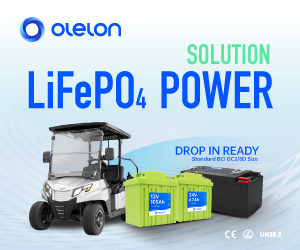When deep cycle batteries in your golf car are properly charged and watered but there are still performance issues, it’s often blamed on the charger or that perhaps one of the batteries is going bad. Often, the issue is merely a result of a poor battery cable connection. Loose connections are a common problem and can happen from both under-tightening and over-tightening of the battery terminal connectors, or from corrosion that can occur over time.
Deep cycle battery terminals are made from lead which is a soft metal that creeps over time, so they must be retightened regularly to maintain proper torque levels. If too much torque is applied when attaching cables to battery terminals, however, it can cause damage and prevent them from making a proper connection. This is why battery manufacturers have recommended terminal torque specifications that vary with the different types of terminals used on deep-cycle batteries.
Depending on the application, there are a number of battery terminal styles that deep cycle batteries can be equipped with. These include UTL, UT, large and small L, Offset S, and SAE tapered post terminals among others. If you are unsure of the type of terminal on your particular set of batteries, you can easily find out from the battery manufacturer’s website looking up the type and model battery for your application.
For UTL and UT battery terminals with threaded studs, the recommended torque is 95 – 105 in-lb. (7.9 – 8.8 ft-lb). For bolt-thru terminals such as large and small L and Offset S, the recommended torque is 100-120 in-lb. (8.3 – 10 ft-lb). SAE terminals have a recommended terminal torque of 50-70 in-lb. (4.2 to 5.8 ft-lb). For other terminal types, consult the battery manufacturer’s recommendations. When measuring terminal torque, use a torque wrench with settings or readings in the 0 – 200 in-lb. (0 – 16 ft-lb) range. Larger torque wrenches can inadvertently exceed the recommended settings or readings, so if you want to be sure on the torque settings use the proper sized wrench to tighten cables to the terminals.
It is also important to consult the battery manufacturer’s recommendations for the proper type and assembly of the terminal hardware. Most manufacturers provide stainless steel nuts and lock washers or plated bolts, nuts, and lock washers with the batteries depending on the type of terminal used. The correct method is to position a lock washer between the nut and the connector (never between the connector and the lead terminal) and apply the recommended torque to completely compress the lock washer without deforming the lead terminal.
Clean terminals will maintain the best connection so if corrosion is observed on the battery terminals and connectors, they should be cleaned with a wire brush and a solution of baking soda and water to neutralize any acid residue that may be on the surfaces. To reduce the formation of corrosion on the terminals, battery manufacturers recommend using a corrosion inhibitor after making proper connections. Never apply grease or other lubricants between the terminals and connectors since they can interfere with the connection.
Check the cables to determine if they are corroded and need to be replaced. Corrosion can extend under the cable insulation where it is often not visible. A good ‘tug’ on the cables can expose weak connections. If new cables or connectors were added during the life of the vehicle, make sure the wire connectors are properly crimped and soldered to the cable ends. Studies have shown that wire cables with crimped connectors that are not soldered to the cable ends can corrode faster and create a high resistance connection between the wire cable and crimped connector. This high resistance can cause excessive heating during discharge and melt the lead terminal causing a loss of connection and permanent damage to the battery. If any of the cables show signs of melted insulation, corrosion under the insulation, or have bare wire showing replace the cables and connectors.
While faulty connections are often the cause of battery terminal meltdowns resulting in poor performance, using properly sized wires with properly crimped and soldered connectors and the proper torque settings will reduce the chances that poor connections will adversely affect battery performance. For additional information on battery terminal types, terminal torque and connection hardware specifications, and proper maintenance of deep cycle batteries visit www.usbattery.com.

























